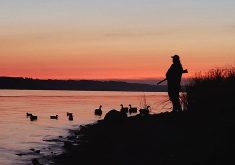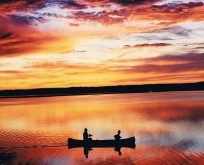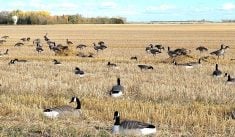It was sunrise on an August morning. I was at the boat launch next to the Delta Beach bridge after getting a “hot tip” about the fishing in the south end of Lake Manitoba (an open secret, it turned out).
There was a guy who was watching a line nearby, so I walked up and asked the usual question: “How’s fishing?”
“Lousy,” he said, which seemed at odds with the two large walleye on his stringer.
Read Also

The long march to autonomy
The big players in the machinery market keep adding pieces towards autonomous vehicles for farming, but how far away is a final product?
He was griping because, the previous week, he had taken his limit and was headed home to catch up on chores by that time of the day.
I went on my way, went through the fuss of unloading and launching my boat and headed about a kilometre offshore. My morning lived up to the billing: I took home a walleye limit, some fat perch and released about two dozen drum.
As I packed up for the trip home though, I kept thinking about how I could have sat in a comfy chair beside the shore-fishing gentleman, with an ice cream stand nearby, and probably would have still come home with a lovely walleye catch.
Pro videos and fishing magazine articles leave the impression that angling requires state-of-the-art equipment. That includes a boat and motor, a trolling motor and fish-finding electronics that, when added up, will cost at least $25,000, and that low only if you buy an older, well-used boat with few bells and whistles. Many folks will declare that I have seriously low-balled this estimate.
Left behind, literally, at the shore are the legions of anglers who come to the water’s edge with their gear in a bucket, a folding chair and a bag of snacks, sunscreen and maybe a mystery novel. The shore angler is invisible in the hyped up, sponsor-driven angling media.
That’s too bad, because fishing from shore is the entry point for many new anglers and the go-to option for those without means or tolerance for the costs and hassles of owning a boat. My late brother ruefully defined his boat as, “A hole in the water, into which I throw money.”

It’s true that, on average, boat anglers will do better than shore anglers, but fishing that’s “good enough” is in the eye of the beholder.
I own boats, but my heart and my head are often with shoreline anglers. My idea of a perfect fishing morning at the family cottage starts at sunrise, with me working likely spots from my boat, but by about 8:30 a.m., the siren call of fresh-made coffee brings me back. Not long after, I’m on the dock with my feet up, a baited line in the water, taking in the morning view.
I’m still there to catch fish, but I also come closer to complete relaxation than I do while in the boat, where I seem to be more locked onto the “catching” part of the experience.
Hunting for shore fishing spots
Our mid-sized and large rivers have some of the highest percentage opportunities for shore anglers. Constrictions like bridges and rapids or barriers like dams and weirs are usually great focal points. Spots where creeks and drains enter the larger water body are also worth checking out.
Generally, the first barrier or constriction upstream of a major water body will be a top-notch opportunity. Two of the best examples are the Lockport dam on the Red River and Pine Falls on the Winnipeg River, both of which draw and hold fish from Lake Winnipeg.
Opportunities await further upstream on the Winnipeg River, especially below dams and other fast-water locations.

Possible access restrictions need to be checked out ahead of time. Always take appropriate safety precautions around swift waters and slippery rocks.
In western Manitoba, the Shellmouth Dam at Lake of the Prairies can be excellent. Mid-sized rivers flowing into Lake Manitoba and Lake Dauphin are also worth a scout. Other popular spots include the weirs on the Assiniboine River in Brandon and Portage la Prairie. In the Interlake, the Fairford Dam on Provincial Trunk Highway 6 can be excellent.
Google Earth is a great scouting tool for a first look at access, current flow and other important details. It can also help you find more secluded, but productive, spots away from roads and bridges. Pronounced river bends often carve out the deepest water on a given stretch of river, which is prime holding water in the summer months.
Lakes are more challenging because fish tend to be less concentrated. That said, any sizeable creek or river entering a lake is a good bet. Points or narrows between two sections may also concentrate fish.
Sometimes finding a location can be remarkably simple. The other day my friend Lorne called while he was fishing from shore near Matlock on Lake Winnipeg. He wanted to compare notes on pruning tomatoes, but his train of thought was interrupted more than once with, “Oh…I got a bite!”
When I finally got his attention and asked where his “hot spot” was, he said that wherever he can get shoreline access and cast out a pickerel rig seems to work for catfish and drum.
In the end, one of the best rules for scouting location is tallying the votes that other anglers leave with their feet. If the shoreline looks beaten down and perhaps strewn with a few minnow tubs, that’s probably a spot worth fishing — and maybe doing some litter patrol.
Basic shore fishing gear
Spinning rods work best for shore fishing because of the position of the reel, especially if you’re using a rod holder, but bait-cast and spin-cast reels will also work.
The key is to make sure your outfit matches the species you might catch. Recently at Lockport I watched a newbie angler joyfully fighting a big catfish, perhaps his first fish. But his gear was far too fragile for cats. When he pulled back hard, the line parted like thread. A small crowd had gathered and it broke our hearts to see this “first fish” moment evaporate.

Passive shore fishing tactics
Most often, shore anglers cast out baited lines and wait. This approach is often called still fishing. Pickerel rigs — premade gangs of two hooks with a snap for a weight and a swivel to tie your line to — are used most often, because they’re inexpensive and they work in many situations. Since snags are a common downside to shore fishing, losing a few of these doesn’t hurt the pocketbook.
If you’re targeting bottom feeders, a “Lindy rig,” where your line slides through a sinker and the hook sits at the end of the line, may be a better choice. It works especially well with cut baits for catfish, but some also prefer Lindy rigs for walleye because you can leave some slack in your line, allowing a fish to swim a bit before setting the hook.
Active shore fishing tactics
I avoid pickerel rigs at locations with currents and a snaggy bottom. Here, slip bobbers can hang bait just off the bottom. It takes some fussing to find the “just right” depth setting, but once you do, snags are much reduced and, because your bait is drifting, you’re working more water compared to a fixed (and maybe snagged) pickerel rig.

Some of our rivers have summer runs of goldeye or mooneye, and slip bobbers fished from shore are an excellent choice. Here, the fish are usually just below the surface, so the rig is set accordingly and paired with a No. 8 or No. 10 hook.
Casting jigs from shore with a twister tail, tube, or plastic worm can also be very effective. Here, the art is to ensure that you work the jig just over the bottom – tickle it, if you will – but don’t let it settle into the rocks. This is a practice-makes-perfect technique. You’ll lose some jigs before you get the hang of it. Fortunately, like pickerel rigs, basic jigs are inexpensive.
More tips for catching fish from shore
When fishing in currents, avoid the urge to cast your line straight out from shore. The current drag on your line may get your weight rolling down river and, inevitably, it will find a snag. Snags like this usually mean a lost rig.
If you have the room, the better approach is to cast about 45 degrees downstream. This reduces current drag and, if you do get hung up, you can pay out some line before retrieving it quickly, which often beats the snag.

I’ve come awfully close to learning the hard way about the need for rod holders. While at Lockport one morning, a friend and I were focused on casting out a second rod while the first one was tucked into a folding chair. We were startled by a clatter and turned to see both rod and chair making a beeline for the river. I got both in time but I learned my lesson. Rod holders are vastly less expensive than a rod and reel and have a long spike that can be pushed into the mud or gravel.
I disagree with folks who think that landing nets are unnecessary. Many fish fall off or break off as folks strain to pull them onto dry land. A net would take the risk out it. Nets with fish-friendly twine also increase survival odds for fish that will be released, especially when compared to dragging them over rocks, gravel or sand.
Be prepared and act quickly when releasing fish. Too many times, I have watched fish flopping on the rocks as an unprepared angler searches for their pliers and/or phone.
Good manners for good fishing spots
There are only so many good shore fishing spots to go around, and it’s first come, first served. The early bird gets the prime spot. Set the alarm early and don’t dawdle over a second cup of coffee.
If someone has beaten you to a prime spot, don’t crowd their ability to cast and fish the area that they got to first. When are you too close? That’s a judgement call. Bottom line, don’t be unreasonable and spoil someone else’s day.
When it’s all said and done, what’s not to like about a low-cost, low-effort approach to angling that, with a bit of planning, offers ample opportunity to bring home fish for the table and memories of a great day outdoors?
















